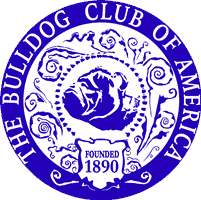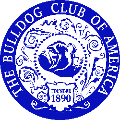AKC Gazette
September 1997
WILLIAM ANDREE
ROLLING GAIT
Our standard says, “The style and carriage are peculiar, his gait being a loose-jointed, shuffling, sidewise motion, giving the characteristic roll.” Almost as an afterthought, it adds, “The action must, however, be unrestrained, free and vigorous.” Worth just three points of the standard’s cumbersome, and therefore rarely used, 100-point scale, gait must seem to the novice exhibitor a rather minor, even trivial, consideration.
This view was widely held by Bulldog judges and exhibitors 50 years ago when I was a child (now called junior) handler. I vividly recall a respected Bulldog judge’s remark: “As long as the Bulldog can make it around the ring without falling down, that’s acceptable.”
But attitudes change. Modern breeders and judges, both specialty and multibreed, expect far more, perhaps too much more. As a result, typical Bulldog gait has evolved into something very different than when it was adopted, or even when I started showing. No respectable breeder-exhibitor today would want their dog’s movement to be described as “peculiar,” as in “strange”.
Likewise, we no longer use “loose-jointed, shuffling and sidewise motion” because the phrase suggests a gait that is at once awkward and comical-looking.
Some folks have convinced themselves that the prescribed sidewise motion is not the same thing as sidewinding, a gait that many consider highly objectionable. Most breeders and judges simply prefer to describe correct Bulldog gait as “unrestrained, free and vigorous,” although these terms can properly be used to describe many other breeds in the show ring.
Try to imagine a “loose-jointed and sidewise” gait that is unrestrained or a free, yet shuffling, gait. How can shuffling be said to be free, unrestrained movement? The apparent incompatibility of these terms has somehow always been overlooked and/or routinely disregarded.
Judges today prefer front-end movement far more typical of tight-shouldered, tight-elbowed terriers than loose-jointed Bulldogs. They want the front feet and legs to move as straight ahead from the shoulders as possible, with no sign of paddling or weaving. Since the standard says nothing specific about the movement of the hindquarters, almost anything seems acceptable, even single-tracking and pacing, as long as it is free and vigorous.
To produce that true “rolling gait” we pretend to admire but seldom see, we must look to several other essential breed characteristics. A Bulldog with a rolling gait will have short front legs and elbows that stand well out from the body, very heavy and widespread shoulders, and a very full and deep chest and brisket deep from the shoulders to the lowest part. The hindquarters will be noticeably narrower and lighter, and the rear legs will be longer than the front legs, producing a somewhat unbalanced effort when in motion. Add to this equation a rather short-coupled body.
Since the rear legs are so much longer than the front and the correct “roach back” is so short, the legs cannot move in harmony at a trot unless the hind legs and feet move off to one side to avoid striking the front feet. Then, because so much weight is concentrated up front, the front feet cannot track straight ahead without the dog losing its balance; the action becomes shuffling in front and sidewise in the rear. Since the stifles are turned out and the hindquarters are so light, the rear feet appear to barely skim the ground when viewed from the rear.
When viewed head-on, the effect is of a nearly off-balance front end followed by a somewhat off-center rear end. At a trot, the dog appears to be roll along the ground like a misshapen ball.
True “rolling gait” must be seen to be appreciated, and I suspect most contemporary breeders and judges would not admit it is correct. Unfortunately, it has nearly vanished, except in a few rare instances, and when it is seen it is often considered faulty.
- William Andree, 204 S. Beach Dr., Monticello, IN 47960.












